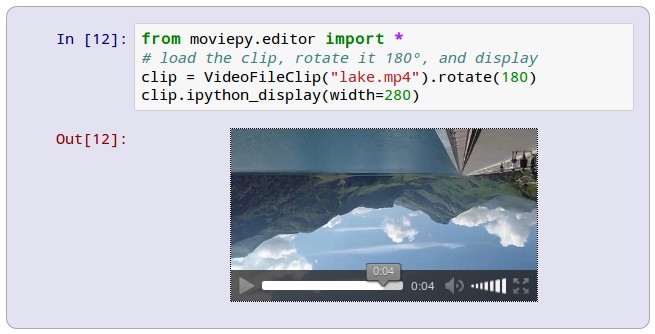FFmpeg VideoStream
High speed video frame access in Python, using FFmpeg and FFshow
This script requires:
- Karl Kroening's 'ffmpeg-python' library. (https://github.com/kkroening/ffmpeg-python)
- ffmpeg.exe + ffprobe.exe in the calling directory or accessible by PATH (https://www.ffmpeg.org/download.html)
Basic Usage
from ffmpeg_videostream import VideoStream
video = VideoStream("my_video.mp4")
video.open_stream()
while True:
eof, frame = video.read()
if eof: break
Methods
VideoStream (path, color, bytes_per_pixel)
- path : The path to your video file as a string :
'/videos/my_video.mp4' - color : The pixel format you are requesting from FFmpeg : By default
'yuv420p'(recommended) - bytes_per_pixel : The number of bytes (not bits) that your pixel format uses to store a pixel : By default
1.5(as per'yuv420p')
Note: By setting color and bytes_per_pixel you can ingest video into any pixel format ffmpeg supports. However, most source files and use cases will benefit by using the default configuration and converting the pixel data to other formats as needed. (See 'Examples')
.config (start_hms, end_hms, crop_rect, output_resolution)
- start_hms : Read frames starting from this time* in the video : ("seek" equivalent)
- end_hms : Stop reading frames at this time* in the video
- HMS times are composed as
[HH:]MM:SS[.m...]orS+[.m...][s|ms|us] - (see https://ffmpeg.org/ffmpeg-utils.html#time-duration-syntax)
- HMS times are composed as
- crop_rect : Accepts a list / tuple as
[x, y, width, height]for cropping the video's input - output_resolution : Accepts a list / tuple as
[width, height]declaring the final scaling of the video, forcing the output to match this resolution
Note: When crop_rect is set, it overrides the .shape() of the final output resolution. This is only important to note if you were to request the crop in a separate call to .config(), AFTER requesting the output_resolution be changed in a previous call. For example...
video.config(output_resolution=(1280, 720))
video.config(crop_rect=(0,0,720,480))
# Hey, just don't do it that way... huh?
.open_stream (showinfo, loglevel, hide_banner, silence_even_test)
- showinfo : When
Trueinvokes ffmpeg's 'showinfo' filter providing details about each frame as it is read. - loglevel : Sets ffmpeg's 'stderr' output to include/exclude certain data being printed to console.
- hide_banner : Shows/hides ffmpeg's startup banner.
- Note: Various 'loglevel' settings implicitly silence this banner. When 'showinfo' is invoked no 'loglevel' output will be printed to console.
- silence_even_test : When
Truesuppresses console warnings that an invalid resolution has been requested.
Note: Invoking 'showinfo' reduces the maximum speed raw frame data can ingest. In most rendering instances the speed reduction is immeasurable due to other blocking processes. But for the raw acquisition of frames it can be significant.
.read ()
Returns an end-of-file boolean flag, followed by a single frame's worth of the raw bytestream from the video. The bytestream data returned is in no way prepared, decoded, or shaped into an array structure. A simple example for converting YUV420p to BGR using numpy and OpenCV is provided:
eof, frame = video.read()
arr = np.frombuffer(frame, np.uint8).reshape(video.shape[1] * 1.5, video.shape[0])
bgr = cv2.cvtColor(arr, cv2.COLOR_YUV2BGR_I420)
Note: The VideoStream class can be initialized to request BGR output directly from ffmpeg, but it is slower to acquire a 24-bit RGB / BGR encoded frame than to acquire the 12-bit YUV pixels and convert them.
.shape () : Returns the final output resolution of the video in a list : [width, height]
.eof () : Boolean indicating whether the end of the file has been reached
.close () : Closes the open stream
.showinfo (key)
- Called without a
key, returns the complete line of 'showinfo' data as a string - Called with
key, searches 'showinfo' for a match and returns the value, orNone
current_frame_number = video.showinfo("n")
Note: All requests return None if showinfo=True was not set during open_stream()
.inspect (attrib)
- Returns a
dict()containing all data found in the 'video' stream of ffprobe if no attrib declared. .inspect("something")returns the value of "something" from thedict()orNoneif not found.
Examples
Timing raw frame access speed
from ffmpeg_videostream import VideoStream
from time import time
video = VideoStream("my_video.mp4")
video.open_stream()
frames = 0
print("\r\nReading VideoStream...")
timer = time()
while True:
eof, frame = video.read()
if eof: break
frames += 1
timer = time() - timer
print(f"\r\nRead {frames} frames at {video.shape()} resolution from '{video.path}' in {round(timer, 3)} seconds.")
print(f"Effective read rate of {round(frames / timer)} frames per second.")
Rendering output to PyGame
from ffmpeg_videostream import VideoStream
import numpy as np
import cv2
import pygame
path = 'my_video.mp4'
video = VideoStream(path)
video.open_stream()
pygame.init()
screen = pygame.display.set_mode(video.shape())
while True:
eof, frame = video.read()
# Shape bytestream into YUV 4:2:0 numpy array, then use OpenCV to convert from YUV to BGR.
arr = np.frombuffer(frame, np.uint8).reshape(video.shape()[1] * 3//2, video.shape()[0])
img = cv2.cvtColor(arr, cv2.COLOR_YUV2BGR_I420)
img = pygame.image.frombuffer(img, video.shape(), "BGR")
screen.blit(img, (0, 0)) # Copy img onto the screen at coordinates: x=0, y=0
pygame.display.update()
pygame.event.pump() # Makes pygame's window draggable / non-blocking.
if eof:
break




